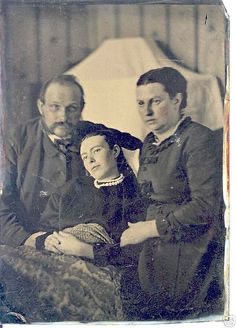
Victorian Death Customs
In England, 1861, Prince Albert died when he was only 42. His wife, Queen Victoria, was so devastated that she wore black for the rest of her life. The rest of the country started doing the same thing when a loved one died, and the death customs grew from there. Although we still wear black and dark colors today, we are pretty lucky that the rest of the customs faded away over time. Though these customs were tradition back then, today we would consider them morbid AF and be totally freaked out if anyone suggested we do the same.
In those days, people usually died at home. As soon as someone died, all of the curtains were closed. The clocks were all stopped in order to “freeze time” and prevent any more bad luck, and all the mirrors were covered so that the dead person’s spirit wouldn’t get trapped in them. If you saw your own reflection in their mirror, some people said you would die too. Pictures in the house were put face down to keep the dead person from possessing someone on the picture. A wreath would be put on the door so people knew someone had died there and funeral invitations were sent out
The funeral was held in the house, so the body was cleaned, dressed, and put in a coffin where it was surrounded by flowers to help hide the smell. The coffin was left on display in the parlor (living room) and left there until the day of the burial. When the body was finally removed from the house it was carried out feet first. This was supposed to keep them from beckoning someone to join them
Families wanted something to remember their dead relatives with. This was called a “Memento Mori” – Latin for “remember you must die”. Sometimes it was something simple like using locks of hair to make jewelry like a locket or a bracelet. There were several other ones that are pretty gruesome by today’s standards:
- Death Masks – Wax masks were sometimes made of the deceased’s face.
- Grave Dolls – To me, one of the worst customs was to have “grave dolls” made that looked like their dead children. The doll would be dressed in the dead child’s clothing, and some of the child’s own hair would be used to make it seem more realistic. The dolls had their eyes closed to make it look like they were sleeping, and the back of the heads were flat so that the doll would lay properly. The dolls of babies were made of their whole body, but for an older child, it was just the head and shoulders. Families would put them on display at the wake, and then leave them at the gravesite after the burial. But sometimes they were kept at home. Since the backs of the heads were flat, the dolls of older children were put in frames. Grave dolls of babies were kept in their crib and their clothes were constantly changed.
- Death Photography – The most common Memento Mori was a picture. In many families, this was the only family picture. The deceased was either pictured alone or surrounded by family. Sometimes the bodies were posed like they were sleeping. Sometimes they painted eyes on the eyelids to make them look alive and awake. Parents either held their dead baby, or they were put in their cribs. Living children were posed next to their dead siblings or with their dead parents. For those pictures, the bodies were sometimes held up with special hidden stands or posed around props. Because of the way cameras processed pictures back then, people usually looked slightly blurry. But because the dead were obviously completely still, they were always perfectly in focus. Creepy but true. There are some amazing pictures in an article about it on BBC.com. The pictures are very unsettling. And I’m not creeped out easily!
- Death Kits – These were made so little girls can prepare for their roles in death rituals, which were mostly left to women. The kits came with a doll, clothes, and coffins. Girls would hold pretend funerals and burial with their dolls. This helped them learn and practice for when they were adults.
There were also mourning rules created (for the women, of course). For two years after a woman’s husband died, she had to wear black dresses made of crepe (a dull form of silk that was very uncomfortable). They wore a veil and couldn’t wear any jewelry. For the first year, they weren’t allowed to leave the house other than to go to church.
https://www.thoughtco.com/victorian-mourning-4587768
